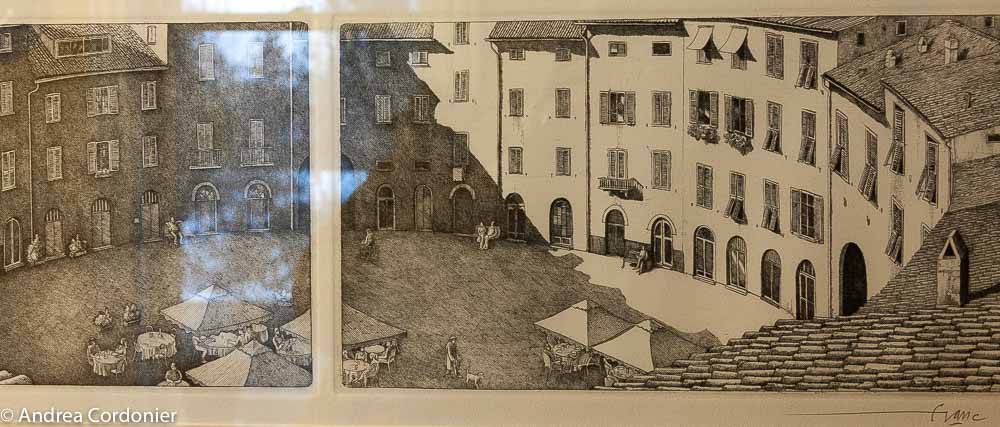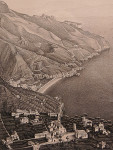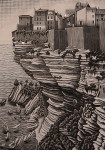For the two years I attended trade school at Algonquin College, Perth became my second home. Between classes I photographed the countryside, explored abandoned buildings, foraged in antique shops and became a regular visitor to Riverguild’s mezzanine, concocting a mental list of the works I would buy from artist Franc van Oort when I’d finished spending money on my greedy old house.
**********
I left a message for writer and journalist Phil Jenkins saying that I wanted to meet him and purchase a copy of An Acre of Time about the history of LeBreton Flats. We met in a cafe in Chelsea, Quebec and after an hour or so of deep conversation he handed me his book. I admired the cover then flipped through the pages. Inside were black and white drawings of botanical subject matter. In the acknowledgements he thanked Franc van Oort for his artistic contributions.
**********
The National Gallery of Canada holds the third-largest collection of M.C. Eschers in the world. Last year’s exhibition, The Mathemagician, featured 54 pieces from this collection, a survey of the various themes found in his work.
As the final days of the exhibition approached the galleries were crowded three bodies deep. My children quickly dispersed to chart their own navigable route through the milieu. I made my way to the end deciding to work backwards, beginning with Escher’s most abstract and theoretical works, worlds of interlocking repetitive shapes where the mathematical and scientific creations took front and centre, towards the magical realism of houses, interiors, people, spheres, self-portraits and finally, the ancient European villages balanced on perilous, linear cliffs.
I was on speaking terms with his most famous pieces like Hand with Reflecting Sphere (1935), Waterfall (1961) and Drawing Hands (1948), moderately familiar with his shape-shifting tessellations and a complete stranger to his landscapes of Southern Italy.
But I stood before a dozen or so of these landscapes for the longest time, struck by their urgent familiarity. How, I puzzled, could I know something that I’d never seen before? It took me two days to realize my unheimliche was on account of Franc.
**********
I’d heard that M.C. Escher‘s son, George, had moved from Mahone Bay, Nova Scotia and was living not forty minutes from me in Kanata. I took to the internet searching for some first-person insight into his father’s work. I came across this YouTube video from the Brooke Valley school just west of Perth. The school had staged a play on Escher’s life and invited George for a post-performance Q&A.
I watched the video and was distracted by the charming tessellated floor so suited to the occasion. It reminded me of my own hand-painted kitchen floor.
**********
I read Phil’s book and sent an email to Franc asking if I could pay him a studio visit.
**********
Franc was born into a long line of artists, which included a master printer, a political cartoonist and his father, an author and illustrator of well-known children’s books. Growing up in Holland he had an early connection to M.C. Escher; as a child he lived just up the road from the Escher family.
My dad would have known, but he never told me. I would have gone and knocked on his door. But then he never would have let me in. He was an intensely private man. He was busy working like my dad.
Franc visited a retrospective of M.C. Escher at The Hague in 1968 and was influenced by what he saw. So when I stared at the landscapes at the National Gallery I was seeing less of Escher and more of the echoes of Franc’s artistic origins.
And to neatly close the circle, he happens to be friends with George Escher and that lovely painted floor in the video? That is the floor of Franc’s barn.
We stopped talking long enough to search through the blueprint- style drawers which held the numbered copies of more than 300 original etchings. I changed my mind half a dozen times before settling on the piece I would buy, an image I’d clung to since I first saw it hanging in the gallery in Perth: the Lucca Diptych (2007).

I photographed Franc in Eyebox, the prototype of his life-size camera obscura, he handed me a signed copy of his book At Home and Away, and off I went. It doesn’t take much effort to find the few degrees that separate any of us.
See: 360° of Franc van Oort (Part 2)
Further reading:
Franc van Oort, Artist & Printmaker
The Mathemagician, M.C. Escher at the National Gallery of Canada
M.C. Escher – The Official Website




One response to “360° of Franc van Oort (Pt. 1)”
[…] Note: There is now a Part 1 which can be found here. […]